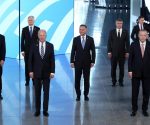Xi Jinping’s reemergence shows how China is controlling the coronavirus narrative
[ad_1]
Xinhua and CCTV are the two most important institutions in the Chinese media, and their coverage typically guides how other outlets cover politically sensitive issues.
The rarity of Xi’s outing, as well as the push to ensure wall-to-wall coverage of it, shows how Chinese authorities are going to play the virus crisis going forward.
Safe locations
While there have been a few hundred cases of the virus reported in Beijing, and three deaths, the capital is nevertheless about 1,000 kilometers (650 miles) from Wuhan, Hubei province — the epicenter of the outbreak. Stringent controls have also been put in place to stop the spread of the virus within the city, much of which remains a ghost town despite businesses reopening Monday, as millions work from home in voluntary quarantine.
During his outing, Xi wore a regular surgical mask, of the type available to most people, rather than a respirator or more sophisticated face covering. Basic masks can block droplets from sneezes or coughs, but they’re recommended for areas where the number of potential virus carriers is low — by comparison, medics in Wuhan itself are often seen wearing full hazmat-style suits.
Xi’s mask use suggests that he was never at any risk of infection. Nor is he likely to be — Xi is the most important person in China, the axis around which the country’s political and military structure rotates. He is the country’s most powerful leader since Mao Zedong, and would never place himself in a position where his health was under threat.
Last month, Premier Li Keqiang — who has been sidelined under Xi but is nevertheless one of the country’s top officials — visited Wuhan itself and met with frontline medical workers. This fits with how China and most other governments handle crises: people want to see that officials are on top of things and feel reassured.
That Xi did not take part in a stage-managed outing like Monday’s before now had led to widespread speculation about what was going on behind the scenes.
Chinese politics, especially at the highest level, is a black box at the best of times. But there was evidence of a struggle by the propaganda and censorship apparatuses to control the narrative around the virus.
And while the desire to avoid fatalism — particularly among the millions of increasingly stir-crazy people trapped in voluntary quarantine across the country — is understandable, it comes as major questions remain unanswered over the Wuhan government and central authorities’ handling of the crisis.
The push for more positive stories may have been setting the ground for Xi’s reemergence, once it was ensured that he could appear as the person to solve the crisis.
Throughout his disappearance from front pages, state media always emphasized that Xi was the one directing the response — a risky strategy that would only work in a country like China where the authorities have absolute control over the media and can censor any who questions them.
Xinhua reported that Xi took part in a video conference on Monday with officials in Hubei. “Wuhan is a heroic city, and people of Hubei and Wuhan are heroic people who have never been crushed by any difficulty and danger in history,” Xi told the officials.
Someone’s getting the blame
But while the people of Hubei may be heroic, the province’s government is increasingly emerging as the villain of this crisis.
The human cost of this was made evident last week, when Li Wenliang, a doctor widely hailed as a hero for attempting to raise the alarm about the virus, died from it. Li had been detained by police in Wuhan for spreading “rumors,” after he warned some university friends in a chat group about a “SARS-like virus” spreading in the city.
It was clear then that a deluge of positive stories would not be enough to turn the country’s mood around — people needed to see someone held to account.
On Tuesday, CCTV reported that two officials in charge of Hubei’s provincial health commission had been suspended, likely just the start of a wholesale purging of the local government.
CNN’s Steven Jiang and Nectar Gan contributed reporting.
[ad_2]
Source link












